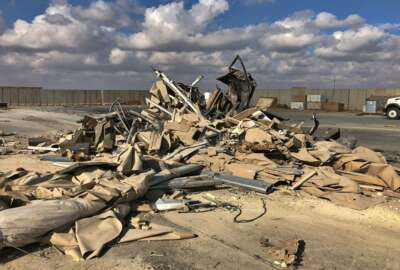
Study shows military helmets have not made much progress resisting shock waves
When it comes to potentially deadly shock waves, modern military helmet designs are not getting the job done.
Best listening experience is on Chrome, Firefox or Safari. Subscribe to Federal Drive’s daily audio interviews on Apple Podcasts or PodcastOne.
Modern military helmets use the latest designs and materials, to protect service members from ballistic and blunt impact. But when it comes to potentially deadly shock waves, helmet designs from a century ago might be more effective. That’s according to researchers at Duke University’s engineering school. To hear what they found, Federal Drive with Tom Temin spoke to Joost Op ‘t Eynde, one of the researchers from the biomedical engineering lab.
Interview transcript:
Tom Temin: Good to have you on the show.
Joost Op ‘t Eynde: Thank you.
Tom Temin: Tell us about what you found out. You subject helmets to shock waves. Tell us how this experiment was set up in what you were trying to get after here.
Joost Op ‘t Eynde: Neither modern helmets nor the historical ones have really been designed to protect against shockwaves. So their design is focused on protecting against bullets and against blood impacts and they are quite effective at that. It’s just that we don’t really know all that well, how they would perform against shockwaves so to kind of take a step back and look at the big picture to see if helmets are good at all at protecting against shockwaves. We were kind of thinking out of the box and trying to go more extreme and be like what if we use these helmets from a very long time ago and compare those and see what the difference in protection is.And so we were very surprised to find that the modern helmet was essentially not better than any of the historical helmets at protecting against, specifically the shockwaves resulting from an explosion.
Tom Temin: And, of course, the shockwaves can produce brain injury just as surely is anything else penetrating the helmet, correct?
Joost Op ‘t Eynde: Yes. So for penetration, anything with penetration, I really want to stress that the modern helmet is so much better than anything we’ve had in the past. We were specifically looking at the disturbance in the air, theshock caused by an explosion, and that can certainly cause brain injuries.
Tom Temin: All right, And which helmets did you use to test this theory?
Joost Op ‘t Eynde: So we used the modern helmet used by the U. S. Army advanced combat helmets. And then we used three different steel helmets from World War one. We use the French design, a British design and a German design.
Tom Temin: How did you subject them to the shockwave?
Joost Op ‘t Eynde: So we have a shock tube, which is a very large, 30 centimeters in diameter tube, which we pump helium gas into. And then there’s a membrane that bursts when a certain pressure is reached. And then that releases a shock wave similar to a shock wave that would be released when an explosion occurs.
Tom Temin: You aim this right straight down on the different helmets?
Joost Op ‘t Eynde: Yes. So we had a dummy head, much like a car crash dummy, that we put the helmet on top of the head. And then we place that at the end of the tube, and then the shockwave would hit them in the head, but with the helmets on top. And then we would record the different pressures to measure how well they deflect the shockwaves, , which is really what would cause the injury.
Tom Temin: And what did you find specifically?
Joost Op ‘t Eynde: One of the very surprising results we found that one of the helmets, a French helmet from World War one, protected better at the top of the head than the other helmets, the modern and historical ones. So that was very surprising to us since the new helmets are so much better protecting against all of these other potential injury causing mechanics. But for shockwave, it seems that they’re not really any better than the historical ones. And in some situations there might be some improvements even that could be made.
Tom Temin: Now that French when you tested is kind of just half a sphere pot that has a little ridge going from the front to back over the middle and just a flared brim. You’ve seen this in a a million movies. What do you think the qualities of that helmet were that made it able to withstand the shockwave so much better?
Joost Op ‘t Eynde: So specifically because we were looking at it kind of an overhead blast coming from the top of the head. We think that Crest might have played an important role in in providing that protection, deflecting the wave off to the side
Tom Temin: That longitudinal ridge, you mean?
Joost Op ‘t Eynde: Yeah the ridge on the top of the head because we saw in the other helmets, the other historical helmets had a flat, more like a flat round the top, much like the modern one does, and we saw comparable results for those historical helmets and the modern helmet not really any of them outperforming the other ones.
Tom Temin: And what do you think are the implications of this?
Joost Op ‘t Eynde: I think one of the implications of this is that there definitely could be some improvements in future designs, whether it would be through some some kind of surface manipulation. I’m not saying the crest might be the most ideal design, but clearly some altering off the surface geometry might have some effect or there could be some material choices that could be made to protect against blasts.
Tom Temin: Because the old one was steel but it had that ridge or that crest. Maybe some ribbing along the helmets of the modern materials might make them more optimized for everything. Do you think>
Joost Op ‘t Eynde: That might still need to be studied further so I don’t have a specific design It? I would say this little for sure work better, but yeah, any kind of changed to the to the surface geometry will certainly have an affected in how it interacts with shockwaves.
Tom Temin: And what will you do with these findings? Will you share them with the Army or the armed forces?
Joost Op ‘t Eynde: Yeah, they’re certainly aware of our results in any new helmet design. They use a lot of computer simulations of shockwaves to look at at how they would perform under different blast scenarios. So I’m certain that they will take these findings into consideration.
Tom Temin: I was thinking this particular experiment that you did was straight down on top is if a shell blew off or exploded overhead. But what happens to that same helmet with the crest, the 1918 version, if the blast was from the side? Probably wouldn’t do that much, would it?
Joost Op ‘t Eynde: I don’t think the crust would really contribute to the affects if the blast was from the side. If the blast is from the side, I think it matters more kind of how deep the helmets it’s over the ears and the neck. And this specific French helmet actually didn’t sit very deep at all that, like the ears were partly exposed. So in that scenario, I think probably the advanced combat helmet might outperform that helmet. But then some of the other historical helmets might perform better. For example, the German helmet kind of had a the brim go down all the way into the neck area, so that might be better from the back or from the side.
Tom Temin: You found that composite materials are a mixture of materials layered seems to be the way to go for most protection functions. Correct?
Joost Op ‘t Eynde: Yes, so the modern helmets already has kind of a layered structure. But from a material standpoint, the way a shockwave is deflected is that every time it reaches a new material interface, a certain portion of the wave is reflected. So if you have a lot of different interfaces back to back, each of those which would create a reflection and potentially that way you could deflect more of the incoming wave. So that might be one of the contributing effects that helps the modern helmet in the blast protection. It might be that it has a layered structure with different materials.
Tom Temin: And finally, I think it’s interesting that this was funded some of this research by an association that goes back to World War one between the United States and Belgium.
Joost Op ‘t Eynde: When I came to Duke from Belgium, part of my master’s research was funded by an organization that was set up during the First World War to provide hunger relief in Belgium. Because of the war, there was a lot of famine, and an organization from the U. S funded some of the hunger relief in Belgium. After the war was over, they said, we still have this fund. What are we gonna do? Is the money just going back? Then they decided to set up on educational foundation. And then 100 years later, through that foundation, I was able to to come study here in the U. S.
Tom Temin: So a nice echo over that century that has passed. Joost Op ‘t Eynde is a PhD candidate at the Duke University School of Engineering. Thanks so much for joining me.
Joost Op ‘t Eynde: Thank you very much.
Copyright © 2025 Federal News Network. All rights reserved. This website is not intended for users located within the European Economic Area.





